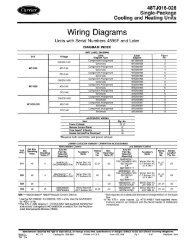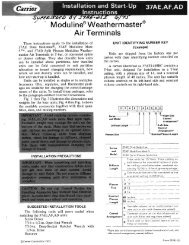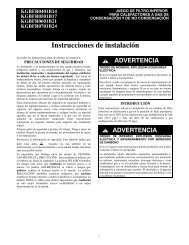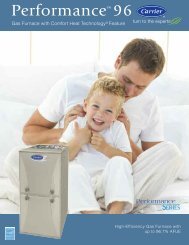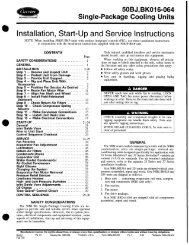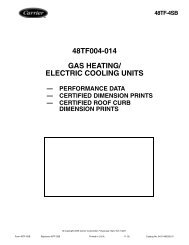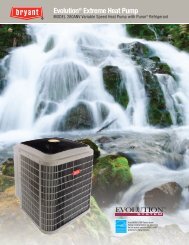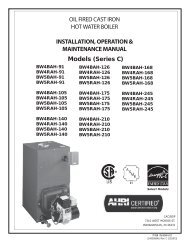Start-Up, Operation, and Maintenance Instructions
Start-Up, Operation, and Maintenance Instructions
Start-Up, Operation, and Maintenance Instructions
Create successful ePaper yourself
Turn your PDF publications into a flip-book with our unique Google optimized e-Paper software.
Water Treatment — Untreated or improperly treated water<br />
may result in corrosion, scaling, erosion, or algae. The services<br />
of a qualified water treatment specialist should be obtained<br />
to develop <strong>and</strong> monitor a treatment program.<br />
Water must be within design flow limits, clean, <strong>and</strong> treated<br />
to ensure proper chiller performance <strong>and</strong> reduce the potential<br />
of tube damage due to corrosion, scaling, erosion, <strong>and</strong><br />
algae. Carrier assumes no responsibility for chiller damage<br />
resulting from untreated or improperly treated water.<br />
Inspect the <strong>Start</strong>ing Equipment — Before working<br />
on any starter, shut off the chiller, open <strong>and</strong> tag all disconnects<br />
supplying power to the starter.<br />
The disconnect on the starter front panel does not deenergize<br />
all internal circuits. Open all internal <strong>and</strong> remote disconnects<br />
before servicing the starter.<br />
Never open isolating knife switches while equipment is<br />
operating. Electrical arcing can cause serious injury.<br />
Inspect starter contact surfaces for wear or pitting on<br />
mechanical-type starters. Do not s<strong>and</strong>paper or file silverplated<br />
contacts. Follow the starter manufacturer’s instructions for<br />
contact replacement, lubrication, spare parts ordering, <strong>and</strong> other<br />
maintenance requirements.<br />
Periodically vacuum or blow off accumulated debris on the<br />
internal parts with a high-velocity, low-pressure blower.<br />
Power connections on newly installed starters may relax<br />
<strong>and</strong> loosen after a month of operation. Turn power off <strong>and</strong> retighten.<br />
Recheck annually thereafter.<br />
Loose power connections can cause voltage spikes, overheating,<br />
malfunctioning, or failures.<br />
Check Pressure Transducers — Once a year, the<br />
pressure transducers should be checked against a pressure gage<br />
reading. Check all eight transducers: the 2 oil differential pressure<br />
transducers, the condenser pressure transducer, the cooler<br />
pressure transducer, <strong>and</strong> the waterside pressure transducers<br />
(consisting of 4 flow devices: 2 cooler, 2 condenser).<br />
Note the evaporator <strong>and</strong> condenser pressure readings on the<br />
HEAT_EX screen on the CVC/ICVC (EVAPORATOR PRES-<br />
SURE <strong>and</strong> CONDENSER PRESSURE). Attach an accurate set<br />
of refrigeration gages to the cooler <strong>and</strong> condenser Schrader fittings.<br />
Compare the two readings. If there is a difference in<br />
readings, the transducer can be calibrated as described in the<br />
Troubleshooting Guide section. Oil differential pressure (OIL<br />
PUMP DELTA P on the COMPRESS screen) should be zero<br />
whenever the compressor is off.<br />
Optional Pumpout System <strong>Maintenance</strong> — For<br />
pumpout unit compressor maintenance details, refer to the<br />
06D, 07D Installation, <strong>Start</strong>-<strong>Up</strong>, <strong>and</strong> Service <strong>Instructions</strong>.<br />
75<br />
OPTIONAL PUMPOUT COMPRESSOR OIL CHARGE —<br />
Use oil conforming to Carrier specifications for reciprocating<br />
compressor usage. Oil requirements are as follows:<br />
ISO Viscosity . . . . . . . . . . . . . . . . . . . . . . . . . . . . . . . . . . . . . . 68<br />
Carrier Part Number . . . . . . . . . . . . . . . . . . . . . . . . PP23BZ103<br />
The total oil charge, 4.5 pints (2.6 L), consists of 3.5 pints<br />
(2.0 L) for the compressor <strong>and</strong> one additional pint (0.6 L) for<br />
the oil separator.<br />
Oil should be visible in one of the compressor sight glasses<br />
during both operation <strong>and</strong> at shutdown. Always check the oil<br />
level before operating the compressor. Before adding or changing<br />
oil, relieve the refrigerant pressure as follows:<br />
1. Attach a pressure gage to the gage port of either compressor<br />
service valve (Fig. 36).<br />
2. Close the suction service valve <strong>and</strong> open the discharge<br />
line to the storage tank or the chiller.<br />
3. Operate the compressor until the crankcase pressure<br />
drops to 2 psig (13 kPa).<br />
4. Stop the compressor <strong>and</strong> isolate the system by closing the<br />
discharge service valve.<br />
5. Slowly remove the oil return line connection (Fig. 36).<br />
Add oil as required.<br />
6. Replace the connection <strong>and</strong> reopen the compressor service<br />
valves.<br />
OPTIONAL PUMPOUT SAFETY CONTROL SETTINGS<br />
(Fig. 39) — The optional pumpout system high-pressure<br />
switch opens at 161 psig (1110 kPa) <strong>and</strong> closes at 130 psig<br />
(896 kPa). Check the switch setting by operating the pumpout<br />
compressor <strong>and</strong> slowly throttling the pumpout condenser<br />
water.<br />
Ordering Replacement Chiller Parts — When<br />
ordering Carrier specified parts, the following information<br />
must accompany an order:<br />
chiller model number <strong>and</strong> serial number<br />
name, quantity, <strong>and</strong> part number of the part required<br />
delivery address <strong>and</strong> method of shipment.<br />
Fig. 39 — Optional Pumpout System Controls







